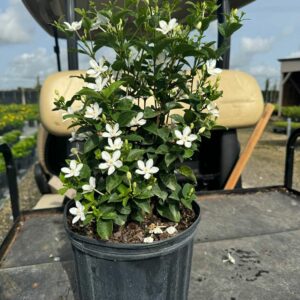Seagrape
Sea Grapes (Coccoloba uvifera) Overview:
Care: Thrives in full sun with well-draining, sandy soil. Regular watering is needed during dry periods, but avoid overwatering. Fertilize during the growing season and prune as needed.
Size: Grows 15-20 feet tall and spreads 10-15 feet wide.
Flowers: Small, greenish-white clusters; not particularly showy.
Hardiness Zone: Best in USDA zones 10-11; not frost-tolerant.
Landscaping Use: Ideal for coastal and tropical gardens, erosion control, and as a windbreak or privacy screen.
Additional Tips: Edible fruit, but often used ornamentally. Tolerant of salt and attracts wildlife. Propagate via seeds or cuttings.
$75.00 – $125.00
Related products
-
All Products
Asian Snow Jasmine
$24.90 This product has multiple variants. The options may be chosen on the product page -
All Products
Clusia
$61.25 – $262.50 This product has multiple variants. The options may be chosen on the product page
Sea grapes (Coccoloba uvifera) are fascinating tropical plants, valued for their unique appearance and versatility. Here’s a comprehensive guide to their care and use:
Care
Light: Sea grapes thrive in full sun but can tolerate partial shade. They need plenty of light to maintain their vibrant foliage and produce fruit.
Watering: These plants are drought-tolerant once established but benefit from regular watering during dry spells. Be cautious of overwatering; the soil should be well-draining to prevent root rot.
Soil: Prefers sandy, well-draining soil. They can tolerate a range of soil types but do best in soils with good drainage. You can improve soil drainage with sand or organic matter if needed.
Fertilizing: Sea grapes benefit from regular feeding during the growing season. Use a balanced, slow-release fertilizer or a formulation suited for tropical plants.
Pruning: Prune as needed to maintain shape or remove dead or damaged branches. It’s usually done in late winter or early spring before new growth starts.
Size
Height: Sea grapes can grow up to 15-20 feet (4.5-6 meters) tall. In their native tropical habitats, they often reach their maximum height.
Spread: They can spread out to about 10-15 feet (3-4.5 meters) wide, so plan space accordingly.
Flowers
Sea grapes produce small, inconspicuous flowers that are usually greenish-white. They bloom in clusters, and while not particularly showy, they are essential for the fruit production.
Hardiness Zone
Sea grapes are best suited to USDA hardiness zones 10-11. They are not frost-tolerant, so they need to be in regions where temperatures don’t drop below 30°F (-1°C).
Landscaping Use
Beach or Coastal Gardens: Sea grapes are perfect for coastal landscaping due to their tolerance for salt and sandy soil. They can serve as windbreaks or natural privacy screens.
Tropical Gardens: Use them as feature plants or in groupings to create a tropical atmosphere.
Erosion Control: Their extensive root systems make them excellent for stabilizing soil and preventing erosion.
Additional Tips
Propagation: Sea grapes can be propagated from seeds or cuttings. Seeds should be planted in well-draining soil, and cuttings should be taken from healthy, mature plants.
Pests and Diseases: They are relatively pest-resistant but watch out for common issues like scale insects or fungal diseases. Regular inspection and maintenance can help keep these issues in check.
Fruit: The grape-like clusters of fruit are edible and can be used in jams, jellies, and other culinary applications. However, they can be quite tart and are often more valued for their ornamental appeal.
Wildlife: The plant attracts various birds and insects, adding to its ecological value.
By providing the right conditions and occasional care, sea grapes can make a striking addition to tropical and coastal landscapes, offering both aesthetic and practical benefits.
| Size | 25 Gallon, 7 Gallon, 15 Gallon |
|---|





